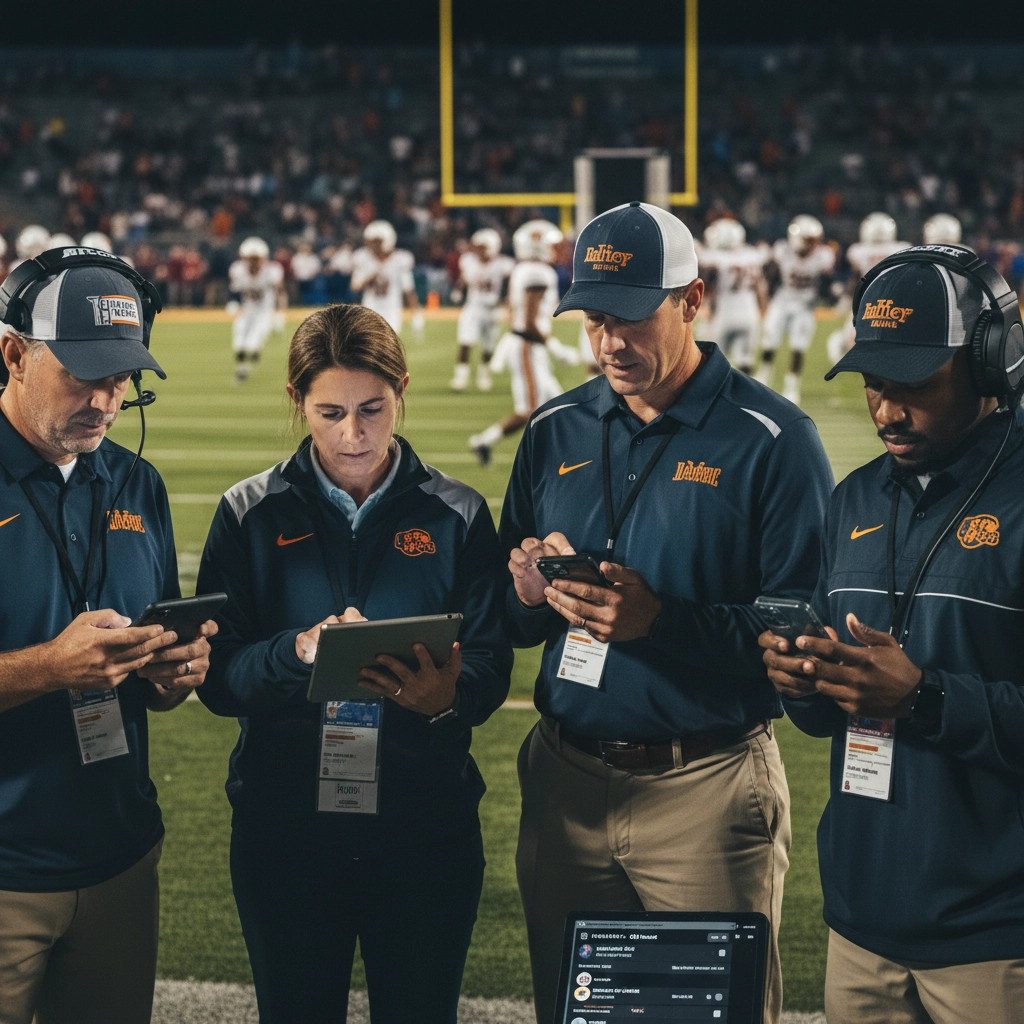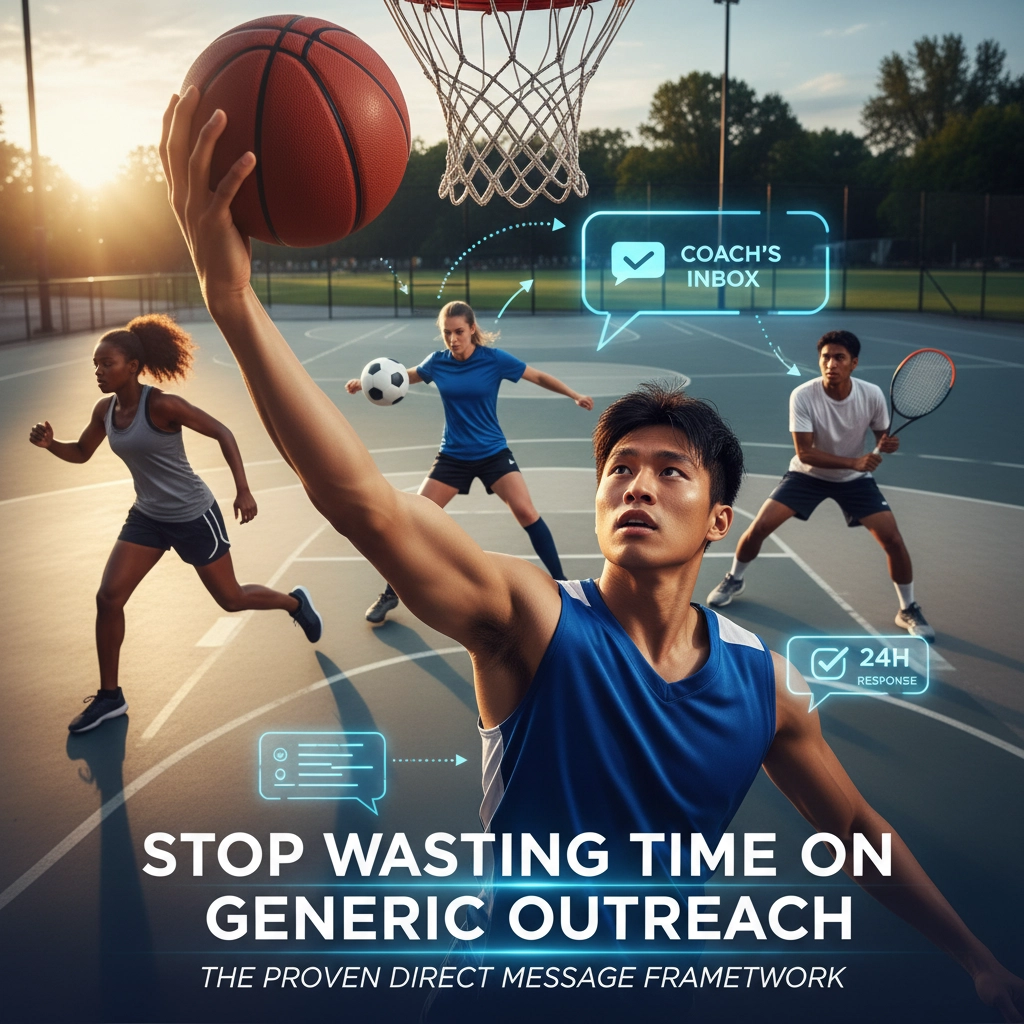The problem is that 95% of student-athletes are sending the exact same generic, templated messages that scream "mass outreach."College coaches receive dozens of copy-paste recruiting messages daily. Most get deleted without a second glance. But there's a proven framework that's helping smart athletes achieve a 30% response rate, meaning 3 out of every 10 coaches they message actually write back, often within 24 hours.
The difference between getting ignored and getting recruited isn't your stats or highlight reel. It's knowing how to start conversations that coaches actually want to continue.
Why Generic Outreach Is Killing Your Recruiting Dreams
Before we dive into what works, let's talk about what doesn't. Most recruiting outreach follows this tired formula:
Subject line: "Recruit Me!"
Opening: "Dear Coach [Name]"
Body: Stats dump and generic achievements
Close: "Please watch my highlights"
Attachment: 12-minute highlight video
This approach fails because it treats coaches like recruiting robots instead of real people with specific needs, challenges, and preferences. When you send the same message to 50 coaches, you're essentially broadcasting that you haven't done your homework.

The Six-Step Direct Message Framework
Step 1: Research Before You Reach Out
Successful outreach starts before you type a single word. Spend 10-15 minutes researching each coach you plan to contact. Look at:
Their recent social media posts
Team's playing style and recent games
Recruiting announcements and commitments
Program needs based on graduating seniors
This research becomes the foundation for personalized outreach that immediately sets you apart from generic messages.
Step 2: Craft an Opening That Demands Attention
Your first message has one job: get a response. Forget about selling yourself immediately. Instead, lead with genuine curiosity or a specific observation about their program.
Instead of: "Hi Coach Johnson, I'm a 6'2" shooting guard averaging 18 points per game..."
Try: "Coach Johnson, I noticed your team's defensive rotations in the championship game were incredible. How do you teach that level of court awareness to new recruits?"
The goal is a 30% reply rate. If you're not hitting this benchmark, your opening needs work.
Step 3: Build Genuine Conversation
Once you get that first response, resist every urge to immediately pivot to your recruiting pitch. The second and third messages should focus on building rapport and demonstrating genuine interest in their program and coaching philosophy.
Ask thoughtful follow-up questions about their responses. Share relevant insights or observations about their team's recent performance. Show that you're engaged with their program beyond just seeing it as a potential landing spot.
Step 4: Identify Their Program Needs
As the conversation develops, start asking strategic questions that help you understand what they're looking for in recruits. This isn't about interrogating them: it's about positioning yourself as someone who thinks strategically about fit.
Questions like:
"What qualities do your most successful players typically have?"
"How important is versatility versus specialization in your system?"
"What's the biggest challenge facing your program right now?"
These questions help you understand their pain points while demonstrating that you think about the game at a higher level.

Step 5: Provide Value Before Asking
Before you mention yourself as a potential recruit, provide something valuable. This could be:
A specific insight about their recent game
A resource related to their coaching challenges
Recognition of their program's achievements
When you demonstrate expertise and genuine interest without asking for anything in return, you shift the dynamic from "student pursuing coach" to "knowledgeable athlete offering perspective."
Step 6: Make the Natural Transition
Only after establishing genuine rapport and demonstrating value should you mention your own recruiting journey. By this point, the coach already knows you're thoughtful, engaged, and different from typical recruits.
Frame it as: "I've really enjoyed our conversation about defensive systems. I'd love to share how my approach to help defense might fit with what you're building at [School]."
The Follow-Up System That Converts
Most responses actually come from follow-ups, not initial messages. Here's the systematic approach that works:
Week 1: Initial message and natural conversation
Week 2: Follow-up referencing something recent about their program
Week 3: Share relevant content or insight
Week 4: Ask about their recruiting timeline
Week 5: Final follow-up with specific next steps
Space your follow-ups approximately one week apart, and always add new value rather than simply asking "Did you see my last message?"
Tracking Your Success Metrics
Successful recruiting outreach requires measurement. Track these key metrics:
Initial Response Rate: Aim for 30% or higher
Conversation Depth: How many messages are exchanged
Call Conversion: How many conversations lead to phone calls
Program Interest: How many coaches express genuine recruiting interest
If your initial response rate is below 30%, focus on improving your opening messages. If conversations die after 2-3 exchanges, you're likely moving too fast to self-promotion.

Common Mistakes That Kill Response Rates
The Stats Dump: Leading with your numbers instead of genuine interest in their program.
The Mass Template: Using the same message for multiple coaches (they can tell).
The Immediate Ask: Requesting calls or visits before building any rapport.
The Highlight Spam: Sending unsolicited video files that clog their inbox.
The Follow-Up Bombing: Messaging daily until they respond (or block you).
Why This Framework Works in Today's Recruiting Landscape
The recruiting landscape has fundamentally changed. Coaches are overwhelmed with messages, highlight videos, and generic outreach. What worked five years ago now gets lost in the noise.
This framework succeeds because it treats coaches as the busy professionals they are. By the time you mention your own recruiting journey, the coach already knows you're different. You've demonstrated that you:
Research their program thoroughly
Understand their coaching philosophy
Think strategically about basketball
Communicate professionally
Respect their time and priorities
The 24-hour response window isn't magic: it's the natural result of sending messages that coaches actually want to read and respond to. When your outreach stands out as genuinely different from the dozens of generic messages they receive daily, coaches respond quickly because they're genuinely interested in continuing the conversation.
Making It Sustainable
This approach requires more time per message but yields dramatically better results. Rather than sending 100 generic messages and getting 5 responses, send 20 personalized messages and get 6-8 quality responses that actually lead to recruiting conversations.
Quality always beats quantity in recruiting outreach. Coaches remember the athletes who took time to understand their program and showed genuine interest beyond just getting recruited.
The athletes who master this framework aren't just getting more responses: they're starting recruiting relationships built on mutual respect and genuine fit. That's the foundation of successful college athletic careers.
Your highlight reel might show what you can do on the court, but your outreach strategy shows who you are as a person. Make sure both tell the story you want coaches to hear.


